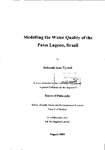Modelling the Water Quality of the Patos Lagoon, Brazil
| dc.contributor.author | Tyrrell, Deborah Ann | |
| dc.contributor.other | Faculty of Science and Engineering | en_US |
| dc.date.accessioned | 2013-09-16T10:08:20Z | |
| dc.date.available | 2013-09-16T10:08:20Z | |
| dc.date.issued | 2005 | |
| dc.identifier | NOT AVAILABLE | en_US |
| dc.identifier.uri | http://hdl.handle.net/10026.1/1737 | |
| dc.description.abstract |
A two-dimensional depth integrated finite element modelling suite comprising the flow model TELEN4AC-2D and the water quality model WQFLOW-2D has been calibrated to simulate the physics and chemistry of the Patos Lagoon and Estuary system in southern Brazil for the investigation of nutrients, primary production and faecal bacteria. The model has been evaluated for use as a predictive tool to aid the decision making process for the rehabilitation and management of the shallow embayment of Saco da Mangueira adjacent to the city of Rio Grande in the lower Patos Estuary. This bay is one of several shallow areas bordering the city which suffers from the water quality pollution problems associated with eutrophication due to the influence of multiple and conflicting human impacts including the disposal of waste water from domestic and industrial sources such as the fertiliser industry, fish processing, and petroleum refining. The validated flow model indicated a very weak circulation in the Saco da Mangueira with velocities an order of magnitude lower than in the estuary. Simulations conducted to evaluate transport and mixing time scales demonstrated limited water exchange between the bay and the estuary principally controlled by wind direction and duration, with efolding flushing times between 21 and 45 days using observed wind and river flow data. The water quality modelling undertaken in this research represents the first reported application of WQFL0W-2D to the Patos lagoon and estuary system, and the first water quality modelling exercise of any kind reported to date for the Saco da Mangueira. Calibration and validation processes demonstrated that WQFLOW-2D could simulate annual average observed concentrations of water quality variables consistently and confirmed the eutrophic nature of the waters within the Saco da Mangueira. The model was used as a comparative tool to evaluate the predicted performance of hypothetical engineering schemes designed to improve the water quality within the bay and water exchange at the mouth. A number of recommendations were made including an imperative requirement for the collection of pollutant input and process data to reduce the level of uncertainty associated with the water quality model. | en_US |
| dc.description.sponsorship | HR Wallingford Limited | en_US |
| dc.language.iso | en | en_US |
| dc.publisher | University of Plymouth | en_US |
| dc.title | Modelling the Water Quality of the Patos Lagoon, Brazil | en_US |
| dc.type | Thesis | |
| plymouth.version | Full version | en_US |
| dc.identifier.doi | http://dx.doi.org/10.24382/3658 |
Files in this item
This item appears in the following Collection(s)
-
01 Research Theses Main Collection
Research Theses Main


